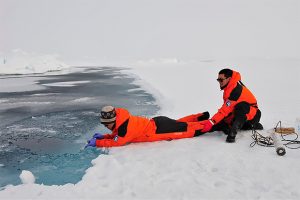Adaptation and Resiliency
This website offers insight into a variety of Arctic issues: from renewable energy in Iceland, coastal erosion and ocean acidification, to Arctic foxes. Challenges in the Arctic, including the ones you will be reading about and watching today, are very diverse and complex. They have many moving parts interconnected to form a bigger whole.
Despite the complexity of issues, there is one large, overlapping theme that we want to identify to help you make connections and see the bigger picture of the Arctic: Some level of climate change is occurring right now and will continue to occur during the next century. There are steps we can take now to prevent catastrophic damage.
This may sound scary. You are probably wondering: So…. What can we do about it?
The good news is that people around the world are asking the same question, and they are working to research and find solutions for problems so that Arctic communities and ecosystems can be strong against changes they are seeing and might see in the future. These solutions are called adaptation efforts that make communities resilient, or able to withstand change without complete damage.
You may want to close your eyes and ears to the problems we discuss. However, we truly believe that it is important to be aware of what is happening in the Arctic so that solutions can be found! We are optimistic that the Arctic region will continue to be a place of incredibly diverse and interesting peoples and species.
So, what effects have already taken place in the Arctic that impact people, animals, and infrastructure?
Coastal Erosion: With a warmer climate comes a major loss in sea ice coverage across the Arctic region. Places that once held sea ice year round may only have it during peak winter time, and even then, the ice is thinner and weaker than ever before. Sea ice is particularly important on the coasts of the Arctic region, especially to indigenous communities. Not only has coastal sea ice been used traditionally to hunt seals and whales, but it also helps protect the coastline from the harsh Arctic waters. Now that coastlines are exposed year round, the coast is subject to harsh winds, waves, and storms that were previously blocked by ice. Less sea ice along with thawing permafrost and higher sea-levels, has increased the rate of coastal erosion exponentially, and endangers local communities throughout the Arctic region. Some communities, like Newtok in Alaska, need to relocate completely before their small community erodes completely.
Melting Sea Ice: with increased temperatures around the globe, the sea ice in the Arctic continues to decrease year by year. This sea ice is necessary for coastal protection, indigenous hunting, and animal populations. The image of a polar bear stranded on a lone piece of ice at sea is a common one, but does have real life implications for the lives of arctic animals. Limited sea ice is a detriment to the usual hunting habits of polar bears, who use the ice to move freely across the Arctic landscape and hunt down seals. Arctic foxes also rely on sea ice to travel and repopulate in areas that are isolated in summer months. Without this sea ice serving as a bridge between different land areas, genetic diversity in Arctic foxes has taken a steady decline, posing a threat to the species should a biological threat arise that easily bypasses immune systems that are all too similar. Fox populations on islands are also at risk, as they no longer have contact with the larger, mainland foxes that help repopulate should hunting or natural predators hurt local foxes.
Melting Glaciers: with melting sea ice also comes melting glaciers. When glaciers melt, the resulting supply of water can very easily flood and disrupt the surrounding ecosystems. In Iceland, they rely on glacier melt for hydroelectric power, creating dams and using streams and rivers from glacier melt to provide renewable energy energy across the country. With unprecedented glacier melt, however, comes overflowing rivers that flood the dams and surrounding areas. Creating new dams is a way to both control the greater water flow and supply even more power, but this infrastructure also affects the surrounding environment and can conflict with local communities. Furthermore, should the glacier continue to melt at these astounding paces, they will eventually disappear altogether rather than continue in a cycle of growth and decay, meaning that the power from glacier tributaries will someday disappear.
With such large changes in the Arctic, what can be done to manage the effects?
One example of how groups are managing the effects of climate change can be seen in the response to ocean acidification. The cold waters in the arctic ocean are particularly susceptible to absorbing carbon dioxide from the atmosphere as global emissions remain high. This results in the acidification of the water and a decrease in carbonate present in the water. Carbonate, however, is essential to shelled organisms to create both shells and skeletons. Thankfully, there are many organizations committed to monitoring both acidification levels and the effects of acidification on shelled organisms to help ensure these species can thrive in the Arctic and maintain the economies of local communities who rely on these resources. With focused research and attention to different colonies of shelled organisms across the Arctic, communities can ensure that these populations can continue to grow even as their environment becomes toxic to their development. Collaborative efforts like this can truly make an impact on the preservation of local ecosystems and cultures, ensuring that life in the Arctic will continue even as the climate continues to change.
Explore! To learn more about the topics listed above, Click any of the images to jump to that Arctic issue



